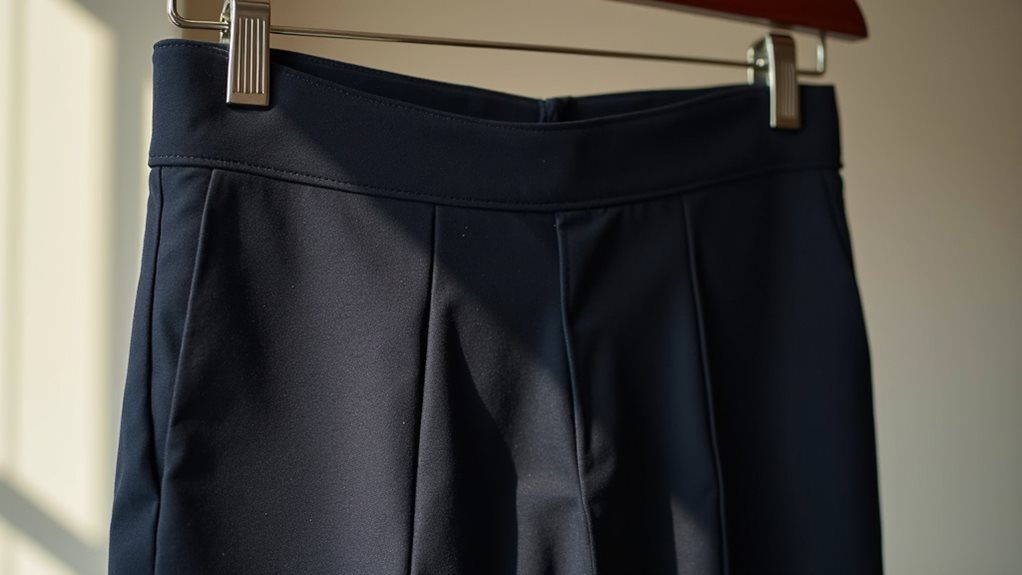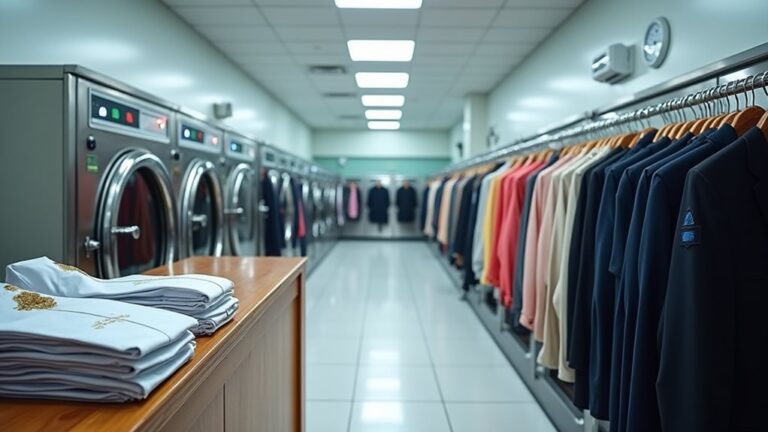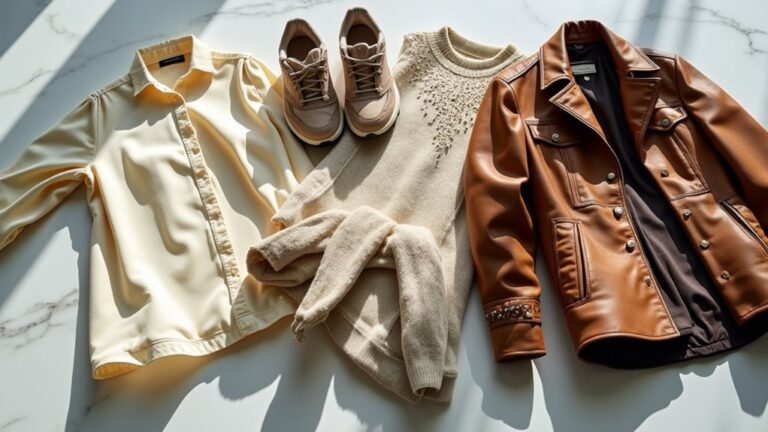You can typically wear dress pants 4-5 times before dry cleaning, though fabric type makes a huge difference in this timeline. Wool trousers, bless their hardy fibers, can handle 18-20 wears since they’re naturally odor-resistant, while cotton pants need attention after just 2-3 wears because they absorb everything like little fabric sponges. Synthetic blends fall somewhere in the middle at 4-5 wears, and there’s more to contemplate beyond these basic guidelines.
General Guidelines for Pants Dry Cleaning Frequency
While I used to think dry cleaning was just another way for businesses to drain my wallet 💸, I’ve learned through some embarrassing wardrobe mishaps that understanding when your pants actually need professional cleaning can save you both money and those cringe-worthy moments when you realize your favorite trousers have seen better days.
Here’s what I’ve discovered: woolen pants can handle 18-20 wears before requiring dry cleaning services, while dress pants need attention after just 4-5 wears.
However, for general maintenance, I recommend having pants cleaned after every 3-4 wears to prevent odors from becoming permanent residents in your fabric.
Don’t let stubborn odors become unwelcome tenants in your pants – evict them with regular cleaning every 3-4 wears.
This approach keeps you looking sharp without breaking the bank, and trust me, your coworkers will thank you.
Between wears, proper care includes hanging your pants correctly and using a clothes brush to remove surface dirt and extend the time between cleanings.
Fabric Type Considerations That Affect Cleaning Schedule
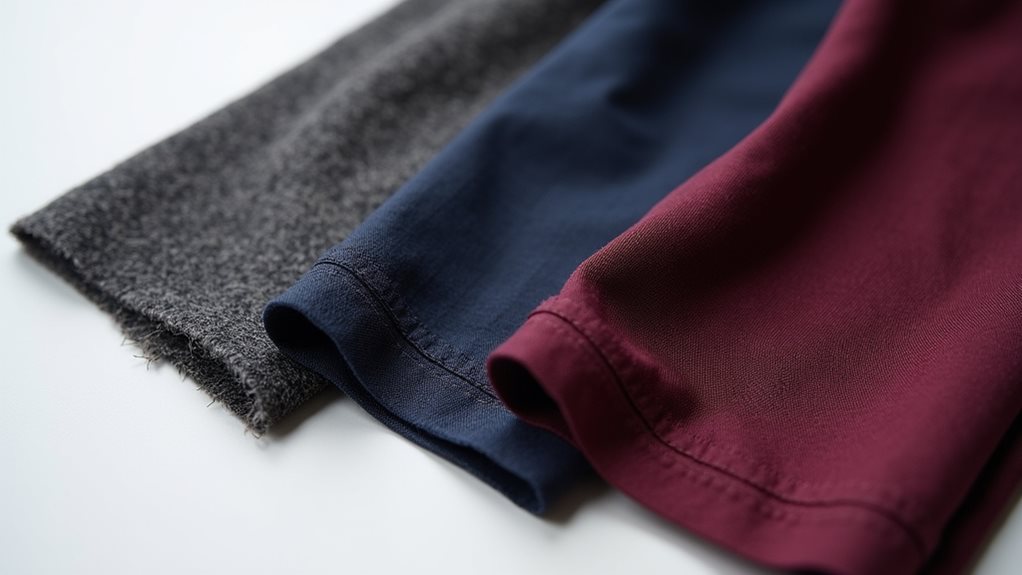
When I first started building my professional wardrobe, I learned the hard way that my cotton dress pants couldn’t handle the same wear schedule as my grandfather’s trusty wool trousers, which seemed to magically repel wrinkles and odors for weeks on end.
You’ll discover that synthetic blends offer a sweet middle ground between durability and breathability, though they sometimes trap odors faster than you’d expect after a long day at the office.
The real game-changer comes when you understand how delicate materials like silk or linen require completely different care strategies, turning your laundry routine into something that feels more like tending a garden than simply cleaning clothes.
These sensitive fabrics need chemical solvents rather than water-based cleaning to prevent shrinkage, color bleeding, and texture changes that can permanently damage their appearance and structure.
Wool Vs Cotton Durability
The fabric you choose for your pants dramatically influences how often you’ll find yourself making trips to the dry cleaner, and honestly, I learned this lesson the hard way after ruining several cotton dress pants in my early career days.
Wool pants are absolute champions in the durability department, lasting 18-20 wears before needing professional cleaning thanks to their natural moisture-wicking and odor-resistant properties.
Cotton pants, while comfortable and breathable, require cleaning after just 2-3 wears because they absorb dirt and odors like tiny fabric sponges.
I’ve watched colleagues rotate the same wool trousers for weeks while I’m constantly shuttling my cotton pants to the cleaner.
Trust me, investing in quality wool saves both money and embarrassment! 😅
The chemical solvents used in dry cleaning are specifically designed to dissolve oils and grease that regular water-based washing simply can’t tackle effectively.
Synthetic Fabric Care
Since synthetic fabrics became my go-to choice for travel pants, I’ve discovered they’re surprisingly forgiving when it comes to cleaning schedules, typically lasting 4-5 wears before requiring a trip to the dry cleaner.
The moisture-repelling properties of polyester and nylon mean you can confidently wear dry cleaned synthetic pants through multiple meetings, dinners, and even light workouts without that telltale “I’ve been living in these” look.
However, I’ve learned the hard way that humidity and sweat can still demand earlier cleaning—especially during summer conferences where I thought I was invincible 😅.
My rule now involves the sniff test and visual inspection after each wear, because synthetic fabrics might resist stains, but they’re not miracle workers against determined perspiration or spilled coffee.
While synthetic fabrics are more durable than delicate materials, dry cleaning’s chemical solvents are still the most effective way to remove oil-based stains and maintain the professional appearance of your tailored synthetic pants.
Delicate Material Guidelines
Delicate fabrics require a completely different mindset than their synthetic counterparts, and honestly, learning this distinction saved me from some expensive wardrobe disasters over the years.
When you’re dealing with delicate material like silk or cashmere pants, you’ll need to get them cleaned after nearly every wear – it’s not negotiable if you want to preserve their luxurious feel and appearance.
I learned this the hard way when I wore my favorite silk trousers three times in a row and noticed the fabric starting to lose its lustrous sheen.
Your delicate pieces are investments that deserve proper care, so don’t try to stretch their wear cycles like you’d with sturdy cotton or denim.
These delicate materials can shrink or be damaged by water and traditional washing methods, which is why dry cleaning becomes the safest option for maintaining their quality and longevity.
Environmental Factors That Increase Cleaning Needs
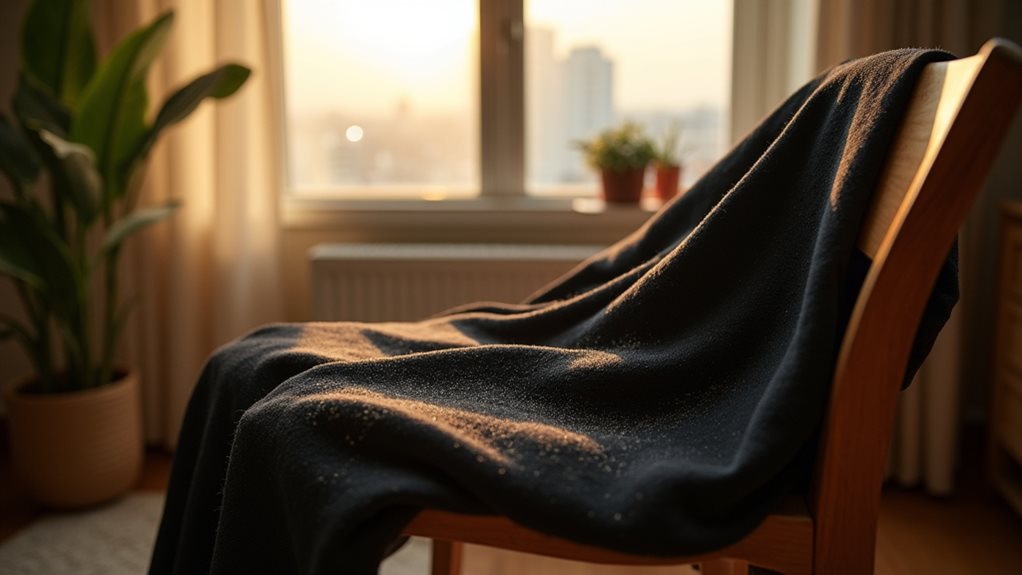
While I’ve learned this lesson the hard way through countless wardrobe mishaps, environmental factors can dramatically accelerate how quickly your pants accumulate dirt, odors, and stains that demand professional attention.
Hot, humid weather makes you sweat more, which means your favorite trousers absorb moisture and develop that unmistakable “lived-in” smell faster than you’d expect.
Sweat and humidity transform your best trousers into odor magnets, demanding professional cleaning sooner than anticipated.
Dusty construction zones, crowded subway cars, and pollution-heavy city streets all conspire against your cleaning schedule, forcing you to wear your pants fewer times before that inevitable dry cleaning trip.
I’ve discovered that even a single afternoon of outdoor activities or traversing busy urban environments can cut your typical wear cycle in half, transforming crisp pants into candidates for immediate professional care.
When you do take pants for dry cleaning, consider choosing facilities that use safer alternatives like wet cleaning or liquid CO2 instead of traditional chemical solvents to reduce potential health risks.
Immediate Care for Stains and Spills
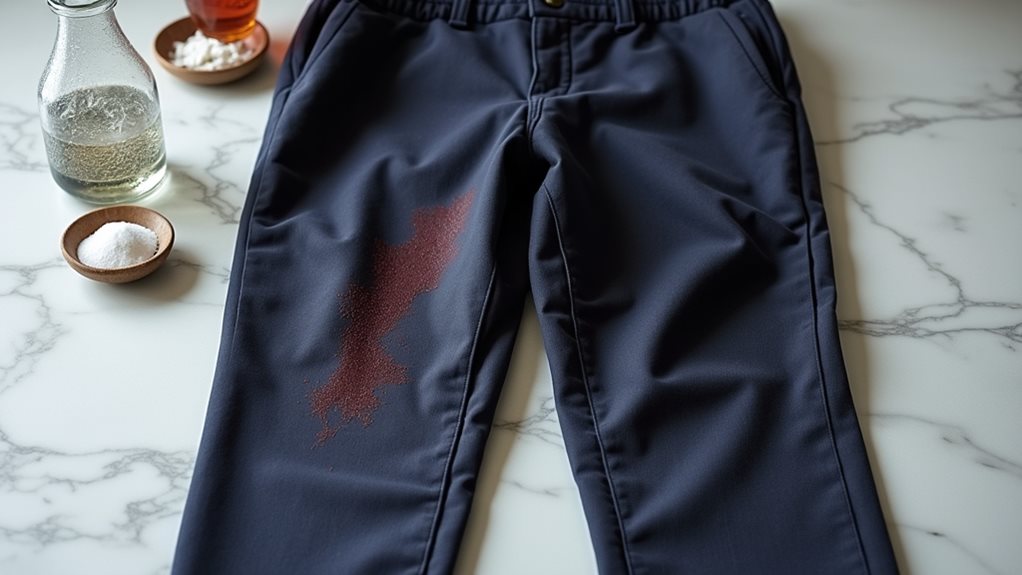
When that inevitable coffee splash or lunch mishap strikes your favorite work pants, your first instinct might be to grab whatever’s nearby and start scrubbing, but trust me—I’ve learned the hard way that rushing into DIY stain removal can turn a minor accident into a permanent wardrobe casualty.
The key is acting quickly while resisting the urge to become your own fabric hero, because those “miracle” home remedies you’ll find online often contain harsh chemicals that can bleach or damage your pants beyond repair.
Instead of playing stain roulette, your best bet is treating the spot gently with cold water and then heading straight to a professional cleaner who actually knows what they’re doing. 🧽
Professional dry cleaning excels at removing oil-based stains, grease, makeup, and protein-based stains like blood or sweat using specialized chemical solvents that regular washing simply can’t match.
Act Fast on Stains
As someone who’s watched countless beautiful pants meet their tragic demise because I thought “I’ll deal with that wine stain tomorrow,” I can’t stress enough how critical those first few moments after a spill really are.
The second something hits your fabric, grab a clean cloth and start blotting—never rubbing, which just pushes the stain deeper into the fibers. For liquid spills, you’ve got maybe ten minutes before they start setting permanently into the weave.
Mix a tiny bit of gentle detergent with water and dab it on immediately. Trust me, those extra two minutes of effort now will save you from explaining to dry cleaners why your favorite trousers look tie-dyed 😅.
When home treatment isn’t enough, professional dry cleaning uses specialized chemical solvents that can tackle oil-based stains, grease, and makeup that regular washing simply can’t handle.
Avoid DIY Removal Attempts
Now here’s where I learned one of my most expensive lessons about stain removal, and I’m hoping you can avoid the same costly mistake I made with my favorite wool dress pants.
When that inevitable stain happens, resist every urge to become a DIY hero with household remedies or vigorous scrubbing.
- Never rub or scrub the stain – this pushes it deeper into fibers and can permanently damage delicate fabrics
- Skip the Pinterest hacks – what works on cotton t-shirts can destroy wool, silk, or specialty blends
- Avoid heat treatments – hot water or blow dryers can set stains permanently
Instead, gently blot excess liquid, rinse with cold water if appropriate, and head straight to your trusted dry cleaning professional who knows exactly how to handle your specific fabric type. While traditional dry cleaning is effective, consider choosing eco-friendly cleaners that use safer alternatives to perchloroethylene, especially if you’re pregnant, have children, or prefer to minimize chemical exposure.
Professional Treatment Importance
Since timing can make the difference between saving your pants and saying goodbye to them forever, understanding when to rush to professional help becomes absolutely critical for preserving your investment.
When you notice visible dirt or mysterious stains appearing on your favorite trousers, your instinct might whisper “I can handle this myself,” but honestly, that’s usually when things go sideways 😅.
Professional cleaning services possess specialized solvents, equipment, and expertise that your home toolkit simply can’t match, especially for delicate fabrics or stubborn marks.
Those “Dry Clean Only” labels aren’t suggestions—they’re lifelines for maintaining fabric integrity, color vibrancy, and proper fit, guaranteeing your pants continue looking sharp rather than becoming expensive cleaning rags.
The dry cleaning process uses chemical solvents instead of water to effectively remove oil-based stains that traditional washing cannot eliminate, making it particularly essential for wool, silk, and structured garments.
Professional Pressing as an Alternative to Full Cleaning
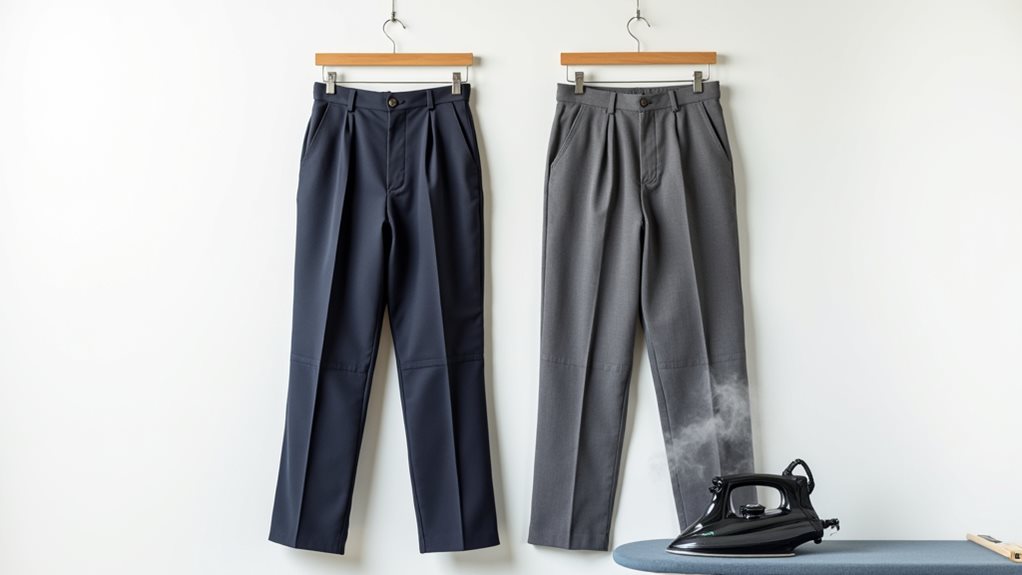
When your pants look perfectly clean but have lost that crisp, professional edge you need for an important meeting, professional pressing becomes your secret weapon for maintaining a polished wardrobe without breaking the bank.
Professional pressing transforms wrinkled pants into crisp, meeting-ready attire without the expense of full dry cleaning services.
I’ve discovered that this middle-ground approach can refresh your pants beautifully, restoring their structure and eliminating those stubborn wrinkles that make you look like you’ve been sitting in your car for hours.
Professional pressing offers several compelling advantages over full cleaning:
- Preserves fabric integrity by avoiding harsh chemicals while maintaining that sharp, customized appearance
- Eliminates minor odors and wrinkles without the wear and tear of complete laundering cycles
- Costs considerably less than traditional dry cleaning while extending your pants’ lifespan between deep cleans
This smart approach keeps your pants looking fresh and professional longer.
Proper Care Between Dry Cleaning Visits

Between those precious dry cleaning visits, the way you treat your pants at home makes all the difference in how long they’ll maintain that fresh, professional appearance you’re working so hard to achieve.
Proper care between dry cleaning starts with rotation – I learned this the hard way after wearing my favorite charcoal trousers three days straight and watching them lose their crisp edge.
Give your pants a day off between wears, allowing the fabric to bounce back naturally. After each wear, gently brush away any crumbs or lint (we’ve all been there with that morning bagel 🥯), then hang them on proper hangers with empty pockets.
A quick steam can work miracles, rejuvenating wrinkles without a full cleaning cycle.
Special Considerations for Suit Pants and Matching Sets

While you might think suit pants follow the same rules as regular trousers, these matching sets demand a completely different approach that I discovered during my first important job interview prep.
Your suit jacket and pants must always be cleaned together, even if you’ve only worn the pants three to four times while keeping the jacket hanging safely in your closet.
Even unworn jacket pieces need cleaning alongside their matching pants to maintain consistent color and fabric integrity throughout the entire suit set.
Here’s what I learned the hard way about suit care:
- Always dry clean matching pieces together to prevent color variations that’ll make you look like you grabbed random pieces from different suits.
- Rotate between multiple suit sets to extend their lifespan and reduce cleaning frequency.
- Treat any stains immediately – delaying professional cleaning makes removal nearly impossible and ruins expensive investments.

